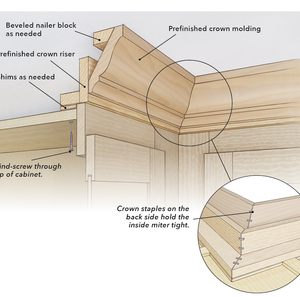Frameless Cabinets With a Traditional Look
A professional cabinetmaker describes his simple methods for making cases and doors.

Synopsis: Here’s a technique for making European-style frameless cabinets that look much like more traditional face-frame cabinets. The author uses simple, time-saving joinery for carcases, doors, and drawers.
I had a little memory-jogging experience the other day when I visited a friend who rebuilds car engines. “Pull my finger,” he told me, but I knew that old joke. “No, really, take a look at this,” and he put his finger on a device he had bought to measure drill-bit diameters. The device has a needle gauge marked in l,000ths of an inch, and every second or so, the needle jumped. “That’s my pulse,” he said. Marveling at the sensitivity of the new instrument, I remarked that 20 years ago I thought I needed that kind of precision in my cabinetmaking shop. Ah, the folly of youth.
I no longer rely on precise measurements and setups. Over the years I’ve developed a cabinet-building system in which, rather than trying to make a cut perfect the first time, I make the piece too big and then pare it down slowly to get the cut just right.
I’ve also learned to disregard nominal dimensions. For example, when making grooves to house 3/4-in. plywood shelving, I take out the 3/4-in. dado, right? No. I ignore the nominal dimension and set the dado to 5/8 in. Then I incrementally widen the groove until the plywood just drops in. The setup takes a little longer, but the results are great.
Here I’ll describe how I use these methods to build frameless cabinets, also called European cabinets. Frameless cabinets have no integral face frames and use 32mm cup hinges and drawer slides. This hardware lets doors and drawers be attached directly to the case. It’s the style of doors and drawer faces that can give frameless cabinets a traditional look.
The traditional look I’ll build here is a full-overlay frame-and-panel door. Full-overlay doors cover the edges of the case, as opposed to half-overlay doors, which leave part of the case’s edges exposed. If I were building a traditional cabinet with a face frame, I might leave that frame totally visible by using inset doors, which hang within the face-frame openings. But face frame cabinets with inset doors and drawers are tougher to build and give you less storage space than the frameless cabinets I’ll build in this article.
Loose-tenon joints are quick and strong
In my small shop, I build doors first because they take up less space than cases. If I built the cases first, I’d be wallowing in them as I built the doors.
When I build a frame-and-panel door or drawer face, I join stiles and rails (the vertical and horizontal parts of the frame) with a loose-tenon butt joint. This joint is as strong as a conventional mortise and tenon, yet it takes much less time to execute because I don’t need any special tools, just a router and a table saw. In this joint the rails butt into the stiles, and both members are mortised so that a separate tenon may be slipped into these mortises like a dowel. After assembling the frames, I rabbet the inside edge, drop in a panel and hold it in place with panel molding.
I use 5/4 stock for frames not just because it looks good but also because the thickness gives more bearing surface for clamping. The thinner the stock, the more likely it is that a clamp may pull a frame out of flat. After jointing and planing the stock, I rip it into in. widths, then cut it to length
on a chopsaw.
There’s a 1/16-in. reveal all the way around the door or drawer face, which means its size equals the case dimensions minus 1/8 in. If I’m hanging two doors in a single opening, the doors will be half the case width minus 1/8 in.Because the rails butt into the stiles, the rails are cut 5 in. less than the overall widths just cited. I save a few cutoffs for setting up the mortising fixture.
For more photos and information on how to make frameless cabinets, click the View PDF button below.


























